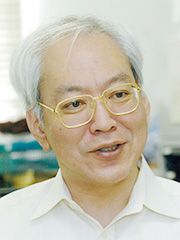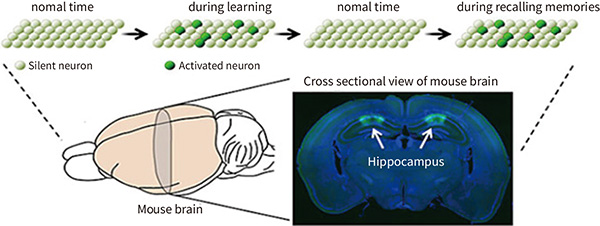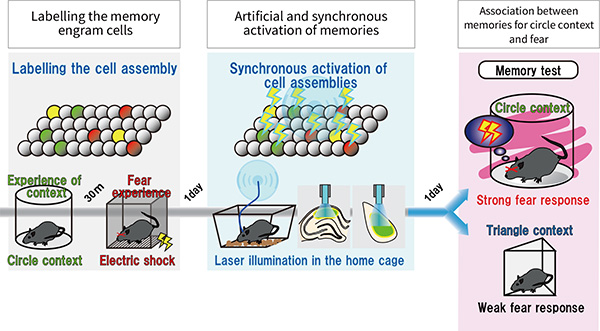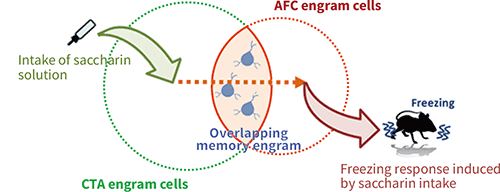Research Results
New Memories Created through Memory Trace Duplication
Closing in on the Mechanism of Memory! FY2018

- Kaoru lnokuchi (Professor, University of Toyama, Graduate School of Medicine and Pharmaceutical Sciences)
- CREST
- Creation of Fundamental Technologies for Understanding and Control of Biosystem Dynamics
"Memory integration process based on cell assembly and neural circuit model" Research Director (2013 - 2018)
New memories generated by artificial association
Our memory has a dynamic character, in that after memories have accumulated once in the brain, they are changed by new experiences and the passage of time. The memories creatures that walk on four legs like dogs are animals and creatures that have wings like a crow and fly through the air are animals are linked, and the memory that animals are such and such things (knowledge, concept) is formed. However, there remain many unclear points regarding the question of how multiple memories link for new memories to be generated.
Professor Kaoru lnokuchi and others worked to elucidate the "mechanism of memory" on the cellular level in the brain, focusing on the property that the information of multiple memories from di erent experiences becomes linked and changes.
Outline of brain and memory engrams

Overlapping of neuron populations is the key
Firstly, they conducted experiments to artificially create new memories in mouse brain.
Mice put into square boxes and given an electric shock soon after cannot link the square box with the experience of fear, so do not exhibit a fear response to square boxes. However, if they are put into a square box and left for a short while so that memories of the place are formed, before being given an electric shock, they come to exhibit fear to square boxes. When we examined the brains of these mice, we found that there were sets of neurons for memories of the place and fear, in areas called the hippocampus and amygdala. These cell assemblies form memory traces for each memory.
Next, the experience of place for a round box and the fear experience to the electric shock are incorporated in the mouse brain as independent memories, after which, the cell assemblies corresponding to both memories were artificially and synchronously activated by optogenetic methods (exposure to laser light). The next day, when the same mouse was put into a round box, a strong fear response was exhibited in a round room, regardless of the absence of the shock.
This result revealed that new memories can be artificially created, by activating the memory traces for two independent memories synchronously.

The second research objective was to elucidate the mechanism known as "behavioral tagging" which is when a person has an intense experience, then the surrounding subtle events are not forgotten, and remembered as well. There are many people who remember very small matters from around the time of the Great East Japan Earthquake, such as the meal they had directly beforehand.
Here too, an experiment was conducted on mice, to have them experience an event together with an intense experience. When they were made to experience only the subtle event, it was forgotten hours later, but if an intense experience was given within one hour before or after the subtle event, then even after hours, the subtle experience was remembered, revealing that an action tag had been established. When we examined the neurons in the brain that were active at that time, we found that the cell assembly that is active when recalling the memory of subtle event and the cell assembly for the intense memory were intensely overlapped. When the cell assembly for the intense experience is suppressed via optogenetic technique, then the subtle event was no longer able to be recalled. Accordingly, we revealed that the co-sharing of two-cell assemblies forms a new memory combining the two originally independent memories.
The third research objective was to elucidate the functional role of overlapping cell assemblies. Here, we linked two different memories, such as "memory of sweet water and fatigue (CTA memory)" and "memory of a buzzer sound and electric shock {AFC memory)." When only the activity of the overlapping cells was suppressed, it was possible to separate the two memories that were already linked. Moreover the two individual memories could be recalled with no trouble.
This revealed that the overlapping parts of cell assemblies play a role in the linking of memories; they are not necessary for recalling individual memories itself.

lmage of memory cell assemblies and the overlapping memory engram, formed by experiences such as saccharin (sweet water) intake, buzzer sound and electric shock.
Toward the process whereby humans produce knowledge and concepts
This revolutionary research by Professor lnokuchi has elucidated some of the mechanisms of memory, of how memories are linked in the brain and new memories are created. This research has produced significant results toward an explanation of higher brain function, the creation of knowledge and concepts from individual memories.
Social interest in results of this kind of research is high; it is widely reported in newspapers, television and internet news, and is drawing attention from many angles.
Hope for new treatments for mental disorders
Ordinary associations between various memories are vital to human beings, but unnecessary links between memories with shallow relations, such as memory of daily events and intense memories are closely associated with mental disorders such as PTSD (post-traumatic stress disorder). The results of this research have the potential to bring about the discovery of treatment methods for people su ering from PTSD, where terrible memories suddenly resurface, and memory disorders such as paramnesia, where the wrong things are remembered to what was actually experienced, if we become able to separate memories without a ecting the original memory.
